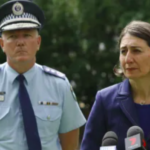Post-Release Reintegration Pathways: An Interview with CRC’s Dr Mindy Sotiri

The NSW prisoner population is on a steep rise. In September, there were 13,017 adults detained in the state’s correctional facilities, according to NSW Bureau of Crime Statistics and Research (BOCSAR) figures. This is despite NSW crime rates being at a 40 year low.
With this ever-increasing number of inmates, comes a growing amount of people having to deal the multiple barriers they face once released from prison. And one of the most significant issues ex-prisoners are confronted with on the outside, is finding secure housing.
UNSW professor Eileen Baldry released a 2003 report that found if a post-release individual has to move residence three times in their first year out of gaol, they’re significantly more likely to return to prison, than someone who didn’t have to move or moved just once.
Prioritising investment
Currently, there’s a shortage of affordable and social housing in NSW. There’s around 60,000 people on the public housing waiting list. And wait times can be from anywhere between five to ten years.
So, those who’ve been released from prison not only have to face the stigma of being a former prisoner when applying for housing, but they’ve also got a huge queue ahead of them.
But, instead of funding much-needed housing, the NSW government is investing $3.8 billion into building more prisons, and expanding existing ones. This will account for an extra 7,000 inmate beds, which can accommodate a more than 50 percent increase in the prisoner population.
Revolving door inmates
Once an individual comes into contact with the prison system, they’re much more likely to be sent to gaol. Recidivism rates in NSW are up around 48 percent. This means that almost half the number of people behind bars will return to prison within 24 months of being released.
Over recent years, there’s also been a sharp rise in the rate of prisoners on remand – those inmates who have been refused bail, and are in detention waiting for the finalisation of their cases. In September, 32 percent of adult prisoners in NSW were unsentenced.
And many of these remandees will eventually be released without having to serve a prison sentence. But they’ll have become acquainted with life on the inside. So, this means that the NSW prison system is potentially creating its very own revolving door prisoners.
Transitioning into the community
The Community Restorative Centre (CRC) provides long-term assistance to prisoners post-release reintegrating into society. As the non-government organisation’s website puts it, “CRC programs aim to reduce crime and break entrenched cycles of disadvantage, offending and imprisonment.”
Sydney Criminal Lawyers® spoke with Dr Mindy Sotiri, program director at CRC, about the key issues facing prisoners on release, what the programs that CRC delivers entail, and the overrepresentation of Aboriginal and Torres Strait Islander people in the Australian prison system.
Firstly, Dr Sotiri, what are the key issues a prisoner faces on release? And how crucial are those initial weeks?
The post-release period, especially the first three months, is incredibly important. We know that’s when a lot of people either return to custody, or relapse into problematic alcohol and other drug (AOD) use, or return to communities that are problematic. So, it’s extremely important.
A key issue, without a doubt, in NSW for people leaving prison is homelessness. So, that’s the number one issue for all of the clients that we work with: that they have nowhere to live when they come out of prison.
The other key issue is that a lot of the people we work with at CRC have really spent a large amount of their lives being managed in criminal justice system settings, rather than being supported in the community.
A lot of the time, the work that we are doing is around trying to build a reintegration pathway, or often an integration pathway for the first time, for people that have often been let down by services in the community.
The issues on release are all around homelessness and poverty. People have $270 in a Centrelink benefit, and that has to last for two weeks before they get another $270.
People often have no means of getting about. They have no social or family support. They’ve often burnt their bridges with friends and family. There are often ongoing and chronic AOD issues, as well as health issues associated with that.
And on top of those really practical and structural concerns, most people when they come out of prison – although they’re very pleased to be leaving – often have huge trepidation about coming back into the community. People often feel very ashamed and self-conscious.
And loneliness for our clients is often one of the most difficult things. Even if we manage to sort out housing, Centrelink payments, and get some food packages, furniture and clothes, often people are desperately lonely.
Even though no one wants to be in prison, there’s often people around, and there’s a community of sorts.
When you’ve spent your life in that community, and you’re wanting desperately to have a different way of living, when you get out, you try to stay away from the people that you used to be friends with, because they’re still using drugs or involved in crime, and you don’t want to do that anymore.
Then it’s really hard to try and find a new community, or a new way of connecting with people in the world.
You mentioned one of the key issues is housing. Currently, there’s an affordable housing crisis in NSW.
What sort of options are out there for individuals leaving prison regarding accommodation? And how important is it that long-term housing is found?
Long-term housing is critical. Whenever we’re talking about what works for people reintegrating, it’s a Housing First approach. That’s where, whenever possible, you move somebody from prison into a property, and then you wrap a whole range of supports around that.
Obviously, in NSW that’s almost impossible. Although, there is a way to do it, so we do it in partnership with some community housing providers.
If somebody is on parole, then they do need to have an address that they’re released to. And more and more, we’re seeing with our clients, that the address is just three nights temporary accommodation through FACS.
Housing will pay for three nights in a cheap motel, so there is an address that you can go to when you leave prison. But after that, you’re pretty much on your own, in terms of trying to sort out your housing options.
If you don’t have parole, then really nothing gets sorted out for you, unless you happen to connect with a service such as ours. We work with around 500 people intensively each year, and there’s something like 18,000 people coming out of prison each year.
We’re not quite sure what the homelessness numbers are. But, some estimates are that close to 10,000 of those people don’t have a proper place to go and live. Although, they might have a friend or a family as a temporary measure.
It’s a massive problem. But, we haven’t built a service system with a solution to it, even though it would be much cheaper to actually invest in social housing and to have that as an option, rather than paying for the expense of people going back to prison.
For our clients, it is without a doubt, the biggest risk factor in terms of why they go back. They literally do not have anywhere to live. And so, they’re forced to go back to, especially for the women, a domestic violence situation, or a violent situation, rather than be homeless.
Or people will return to communities or places where they can sleep on somebody’s lounge, but it’s not going to be a healthy or good environment for them.
So, for the option of trying to make a break, housing is absolutely at the centre of that.
CRC provides transitional workers to help inmates back into the community, as well as providing a range of post-release and reintegration programs.
Can you give us a broad outline of what CRC actually does? And what some of the programs entail?
The programs are funded through 12 different funding streams, so different programs have different emphases.
There are some that really focus on AOD. There are others that are focused on specific geographic locations. And there are some specifically for Indigenous people.
But, they all have basically the same model. The first component of it, that’s really important, is the pre-release engagement. So, our transitional workers will meet with somebody prior to their release – ideally around three months prior – and start the process of planning for release then.
We don’t just start looking at their practical needs – although that’s important (housing, welfare and employment) – but also, we try and talk to somebody about who they want to be when they come out of prison.
We’re less focused on ‘offending’ behaviour that a lot of other programs. We’re not so interested (initially at least!) in getting people to look deep into what it is that they have done, and why they ended up in prison. That’s not really the focus of a lot of our programs.
It really is on: who do you want to be when you come out of prison? What are the things that are going to connect you to the community? What are the hooks, or the anchors, that we can use when you’re out in the community, so that we can assist with actually trying to build an identity outside of the criminal justice system? That’s the start of the process.
On the day of release, our transitional worker meets the client at the prison gate. We’ve found that a very important part in putting together a model that works. Because, we used to find if we’d wait for the people to turn up to appointments, often they just wouldn’t show up. There’s a lot that can happen in those first few hours after you’ve left custody.
On that first day, our workers do a lot. Often people are released with no clothing. They’ve often only got their prison greens, or they’ve changed shape since they’ve been in prison. A lot of people put on weight when they’ve been in prison and don’t fit the clothes that they were brought to prison in.
So, they have to go shopping. Our workers will take them to Kmart or Vinnies. And then set them up with some form of housing, even if it’s a shorter-term thing.
But, basically, we will go with them to every appointment. And there are many. Often there are multiple appointments to get to on the first day. You’ve got to get to parole, to housing and to Centrelink. You’ve often got to get to the bank to sort out your bank account details. You’ve got to get your ID sorted out. And often, there’s debts that need to be dealt with.
Our workers work very intensively with people for the first few weeks after they’ve got out of prison, and organise a whole range of pretty practical things.
Then we’ve got a long-term casework model, where our workers will ideally work with people for 12 months, and sometimes longer than that.
We find that many programs now are only funded to work with people for very short periods of time. Twelve weeks is the standard. But, we know with this population in order to build a proper pathway you need a long-term support model.
So, we are always struggling to find funding providers who are up for that. And it’s quite a big sell, because we’re not working with the numbers of people that we would be if we were doing a shorter-term model.
But, we’ve stuck to our guns with this one, because even the promise for somebody coming out of prison of having one worker that’s going to be with them for the long haul is an incredibly powerful tool – just knowing that there is going to be one person in your corner.
The other key aspect to the model is that our workers are advocates for our clients. It’s a very honest and transparent relationship. But, they are also very much in their corner.
If things go wrong, and there’s a problem with Centrelink or Housing, then our workers will really support our clients to figure a way around that.
If people are being discriminated against because of their criminal record, or if there are issues that people need support with in terms of a custody matter with their children, our workers will be working very hard with our client to try and get them the best services that they can.
And also, just demonstrating that they’re not alone is one of the key reasons why this model appears to work in the way that it does.
You were saying that you engage with the prisoners pre-release, so you’re talking about a throughcare model?
Throughcare can mean many different things.
But, the thing with throughcare that makes a difference with our clients, is that it’s the same person that they meet in prison that is there on the day that they’re released. So, it’s like a metaphorical bridge in a way. That worker operates to smooth that transition from prison into the community.
It’s very important that it’s the same person, as it’s around connecting with that person. But, yes, broadly speaking it is throughcare.
Often the focus when talking about prisoners can be on men. In September, there were around 12,000 male inmates in NSW correctional facilities, compared with only around 1,000 women behind bars.
However, ABS figures from March show that nationally the number of women prisoners had increased by 13 percent over the previous 12 months, compared with the male prisoner population only having grown by 6 percent.
So, what sort of issues do the steadily increasing number of women coming out of prison face that differ to that of their male counterparts?
For years the gender disparity has meant that the gender specific needs of women coming out of prison have historically been overlooked because they’ve been such a small population.
But, I actually do think, in terms of the service landscape, that’s changed a bit over the last couple of years. There has been a recognition that there is a need to focus on specific support for women who are in prison.
The key issue for the women that we work with, and generally for women in prison, is their level of disadvantage and trauma is immense. The vast majority of the women that we work with have themselves been victims of crime, and often, gendered violence of some sort.
When you’re building responses for that, you really need to build a trauma-informed model into the support service.
The other key issue is that most of the women we work with have children. So, separation from children, and having lost custody of children, are the biggest issues for women in prison. And often it’s described as the hardship that is much greater than the loss of liberty.
That separation of children really defines what a period of prison feels like or looks like, or how it is experienced, for women in prison.
Of course, men in prison miss their children, and it’s an issue. Often for men that we work with, there is a woman somewhere on the outside looking after their children. But, often for the women that we work with, that just isn’t the case. The children often end up in the care of the state.
It’s a cycle. We know that about 50 percent of women in prison were themselves in out-of-home care as children.
So, breaking that cycle of intergenerational imprisonment and intergenerational removal of children from families as a consequence of imprisonment – especially in Indigenous communities – is probably the key issue and area of concern, in terms of advocacy for us, with that client group.
CRC programs are aimed at reducing reoffending. But, around 48 percent of people who leave NSW prisons, return within the next two years.
In your opinion, what is it about the criminal justice system/prison system in this state that is leading to such a high recidivism rate?
One of the things that is really clear is that the experience of imprisonment itself is a key risk factor in recidivism.
Those recidivism figures are for the general population. But, if you were to look at a population that has spent most their life in prison, which is the population we work with, those figures go up considerably.
If you’ve spent a couple of times in prison, your risk of recidivism goes up to around 52 percent. And that keeps going up the more times you go to prison.
We need to look outside of the criminal justice system entirely to look for the answers in terms of what the solution is to reduce recidivism and to reduce the re-offending rate.
Also, the housing crisis can’t be overstated. It’s just so important. And obvious on one level.
If you don’t have anywhere to live, and you don’t have anybody to care for you, or to care about what happens to you, and if you’ve spent your whole life in chronic disadvantage, and you’ve grown up in a community where drug use, crime and violence are normalised, even if you were absolutely desperate to make a change – and many people are desperate to make that change – how on earth do you do that without a place to live, and without somebody to care for you, or to support you in that change?
To me, it’s miraculous that people do stay out of custody given the trajectory that they’ve been on prior to imprisonment.
We know that the vast majority of people in prison come from histories and backgrounds of extreme social disadvantage. And it seems almost too obvious to restate that, because we all know that’s why people go to prison.
This is not to understate or minimise the crime, but what is clear when you look at the prisoner population is how many poor people are in there, and how many people are from just a handful of suburbs in NSW: the most disadvantaged suburbs. How many people were in out-of-home care as kids, and how many people were in juvenile justice as kids.
We know many Indigenous people are imprisoned. And we know people are there because they are from communities of disadvantage.
But, when it comes to them coming out, what we tend to do, and I think it’s a mistake, is say, “Let’s focus on the individual and how they are going to address their offending behaviour.” That’s the focus of a lot of programs at the moment. “How are you going to demonstrate that you’ve rehabilitated yourself?”
But, what we’ve been saying at CRC for a while is, “It’s important that people take individual responsibility for their crimes and their actions. But, what are we going to do in the community to actually allow people to be able to do that?”
Because, you can’t do that in isolation. Rehabilitation can’t be undertaken individually and by itself. You actually need a community that is going to find somewhere for that person to live. You’re going to need a community that is going to open their arms a little bit and say, “OK, you’ve done your time. Now, we will give you a job, even though you’ve got a criminal record.”
All the barriers to reintegration are partly our responsibility. And obviously, taking responsibility for the crime is up to the person.
We’ve had a very individualised approach to how we expect the reduction in re-offending to occur.
From the research that we’ve done, and the outcomes for our clients, which are really low in terms of their recidivism, we know that it takes a lot more than that.
It takes a worker to be in their corner. And it takes a huge amount of effort and support in order to really assist somebody to build a sustainable pathway outside of the criminal justice system.
The NSW government is currently investing in more prison beds, even though, crime rates are a forty year low.
Your organisation is trying to reduce the numbers of prisoners behind bars, while at the same time, the government seems to be gearing up to imprison more people.
What do you think about the measures that are currently being taken by the government?
It’s a tricky situation. We know that when you build new prisons, they get filled. That’s always been the case. And crime rates have been stable in NSW for a couple of decades in most of the major categories.
So, we’ve got this increasing prisoner population, and either steady or declining crime rates, which makes no sense at all.
Prison beds get built in response to overcrowding. The reasons for overcrowding are complex. And I’m not an expert on that.
But, my understanding is the bulk of the overcrowding has occurred in short-term and remand populations. The increase in the remand population has been significant, and is perhaps down to changes in bail legislation, or to court backlogs.
From my perspective, it seems a tragedy that there is this level of investment. NSW is a fairly well off state at the moment. We’ve got quite a lot of cash to spend. And the government’s doing that. But, unfortunately, I feel it’s really misdirected.
If you were to funnel those dollars outside of the criminal justice system, then you would have a much cheaper and much more effective response in terms of actually getting people out of there.
There’s a lot of money that has been put into reducing re-offending programs, but I don’t think that’s where the answers are either. The answers are looking at those really basic structural and welfare issues.
Aboriginal and Torres Strait Islander people now make up 28 percent of the nation’s adult inmate population, while accounting for around 2.8 percent of the overall Australian population.
Deaths in custody remain high, but Indigenous people are more likely to die in the days and weeks following release from prison. And there is a gaping lack of assistance and programs available for them post-release.
You’re at the frontline of this situation. In your opinion, why is the Australian criminal justice system failing the First Nations peoples in such a devastating way?
Imprisonment and the institutions of punishment have been failing Indigenous people for a couple of hundred years. It’s an extension of a really tragic and racist past.
I don’t think there’s any other way to understand the overrepresentation other than looking front on at the fact that Indigenous people are overrepresented at every single stage in the criminal justice system: overpoliced, arrested more, granted bail less. At every point, there’s an overrepresentation.
Again, it comes down to the disadvantage, which comes down to a history of colonisation and genocide. I don’t think there’s any great mystery around where this has come from. It’s a tragedy that we haven’t looked at structurally what needs to happen.
It’s not about building prisons that are more specifically able to cope with the needs of Indigenous people. It’s about building pathways way outside of the criminal justice system.
Our thinking with this, is that Indigenous communities absolutely hold the answers to all of these issues. People need to work with Indigenous communities around what those answers are. And we need to resource those communities properly.
Not with short-term pilots and fixes, but with actual proper resources. In the same way proper resources are funnelled into building prisons. We need to put those sorts of resources into the communities where Indigenous people are dying and going to prison.
Again, I know it’s more complex than that in terms of what the service delivery looks like. But, I don’t think we’ve even got to the point of acknowledging where those resources need to go.
There’s some encouraging examples in terms of Justice Reinvestment, and Indigenous led responses scattered about NSW and the rest of Australia. But, we’ve got an enormous way to go with that one.
And lastly, as you said, around 18,000 people are released from prisons every year. However, CRC can only provide assistance to about 500 ex-inmates.
How would you describe the advantage that is gained by former prisoners who receive your services? And what sort of impact does CRC have on these people’s lives?
We’ve got some pretty solid outcome data, when we look at people that have completed our program.
So, for the people we worked with on one of our core men’s programs in Sydney and then exited between 2008 and 2012, we found that our return to prison rate was only 12 percent after 2 years. That was a small sample of about 132 people.
But, even before that we knew from our own data collection that we are having an impact with that long-term support model with pre-release engagement, and a supportive case worker, which is kind of straightforward.
It’s old school social work in a way. It’s very unpopular, and again difficult to get funding for. But, we know it works.
The other things are a bit harder to measure. But, with sustainability of tenancy and also quality of life, health and AOD use, we’ve had some incredible outcomes.
So, independent evaluations of our various projects have all the clients reporting that their connection with a particular worker, or a program, has been lifesaving. They say that they couldn’t have done without it.
That’s not just CRC. That’s any program that’s really doing solid supportive long-term work. It’s not that we’ve designed something that is totally unique. But, it’s a template that works.
The thing our clients report as incredibly effective is having a worker that they felt genuinely cared about them, and also, that is able to really model a whole range of different behaviours too.
So, the relationship between the caseworker and the client is incredibly important. Having somebody that is able to demonstrate how to go into a coffee shop and order a coffee without losing your temper at the barista if they are taking too long, or looking at you weirdly.
And modelling how to go to a gym. A lot of people go to the gym in prison and are really comfortable with that. But, they’re terrified about going to Fitness First in Newtown.
So, it’s important to have a worker that can actually walk beside you during all of those things that a lot of us in the community think are totally easy, but for people coming out of prison, are really complex.
That relationship is so important. And the housing aspect, the fact that we keep going until we have people housed is incredibly important as well.
It’s about having realistic expectations about what the outcomes are, and also knowing that there’s a fairly straightforward solution, which is really about having one solid worker attached to somebody when they leave custody.
Dr Sotiri, thanks very much for taking the time out to have this chat with us today
That’s fine. Thank you.







